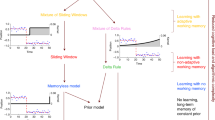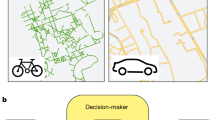Abstract
Individuals differ widely, and the same person varies over time, in their tendency to seek maximum information versus their tendency to follow the simplest heuristics. Neuroimaging studies suggest which brain regions might mediate the balance between knowledge maximization and heuristic simplification. The amygdala is more activated in individuals who use primitive heuristics, whereas two areas of the frontal lobes are more activated in individuals with a strong knowledge drive: one area involved in detecting risk or conflict, and another involved in choosing task-appropriate responses. Both of these motivations have engineering uses. There is benefit to understanding a situation at a high enough level to respond in a flexible manner when the context is complex and time allows detailed consideration. Yet simplifying heuristics can yield benefits when the context is routine or when time is limited.
Access this chapter
Tax calculation will be finalised at checkout
Purchases are for personal use only
Preview
Unable to display preview. Download preview PDF.
Similar content being viewed by others
References
Levine, D.S., Perlovsky, L.I.: Simplifying Heuristics versus Careful Thinking: Scientific Analysis of Millennial Spiritual Issues. Zygon (in press)
Perlovsky, L.I.: Toward Physics of the Mind: Concepts, Emotions, Consciousness, and Symbols. Phys. Life Rev. 3, 23–55 (2006)
Perlovsky, L.I.: Neural Networks and Intellect: Using Model Based Concepts. Oxford University Press, New York (2001)
Tversky, A., Kahneman, D.: Judgment Under Uncertainty: Heuristics and Biases. Science 185, 1124–1131 (1974)
Tversky, A., Kahneman, D.: The Framing of Decisions and the Rationality of Choice. Science 211, 453–458 (1981)
Levine, D.S.: How Does the Brain Create, Change, and Selectively Override Its Rules of Conduct? In: Kozma, R.F., Perlovsky, L.I. (eds.) Neurodynamics of Higher-level Cognition and Consciousness, pp. 163–181. Springer, Heidelberg (2007)
Levine, D.S.: Seek Simplicity and Distrust it: Knowledge Maximization versus Effort Minimization. In: Proceedings of KIMAS (2007)
Levine, D.S., Perlovsky, L.I.: A Network Model Of Rational Versus Irrational Choices On A Probability Maximization Task. In: Proceedings of the World Congress on Computational Intelligence (2008)
Levine, D.S.: Angels, Devils, and Censors in the Brain. ComPlexus 2, 35–59 (2005)
DeMartino, B., Kumaran, D., Seymour, B., Dolan, R.: Frames, Biases, and Rational Decision-making in the Human Brain. Science 313, 684–687 (2006)
DeNeys, W., Vartanian, O., Goel, V: Smarter Than We Think: When Our Brain Detects We’re Biased. Psychological Science (in press)
Damasio, A.R.: Descartes’ Error. Grosset/Putnam, New York (1994)
Schoenbaum, G., Setlow, B., Saddoris, M., Gallagher, M.: Encoding Predicted Outcome and Acquired Value in Orbitofrontal Cortex During Cue Sampling Depends Upon Input from Basolateral Amygdala. Neuron 39, 855–867 (2003)
Dias, R., Robbins, T., Roberts, A.: Dissociation in Prefrontal Cortex of Affective and Attentional Shifts. Nature 380, 69–72 (1996)
Posner, M., Petersen, S.: The Attention System of the Human Brain. Annual Review of Neuroscience 13, 25–42 (1990)
Botvinick, M., Braver, T., Barch, D., Carter, C., Cohen, J.: Conflict Monitoring and Cognitive Control. Psych. Rev. 108, 624–652 (2001)
Brown, J., Braver, T.: Learned Predictions of Error Likelihood in the Anterior Cingulate Cortex. Science 307, 1118–1121 (2005)
Shallice, T.: From Neuropsychology to Mental Structure. Cambridge University Press, New York (1988)
Carpenter, G.A., Grossberg, S.: A Massively Parallel Architecture for a Self Organizing Neural Pattern Recognition Machine. Comp. Vis., Graph., & Image Proc. 37, 54–115 (1987)
Krawczyk, D., Levine, D.S., Ramirez, P.A., Togun, I., Robinson, R.: fMRI Study of Rational versus Irrational Choices on a Ratio Bias Task. Poster submitted to Annual Meeting of the Society for Judgment and Decision Making (2008)
Yamagishi, K.: When a 12.86% Mortality is More Dangerous Than 24.14%: Implications for Risk Communication. Appl. Cog. Psych. 11, 495–506 (1997)
Denes-Raj, V., Epstein, S.: Conflict Between Intuitive and Rational Processing: When People Behave Against Their Better Judgment. J. Pers. Soc. Psych. 66, 819–829 (1994)
Pacini, R., Epstein, S.: The Interaction of Three Facets of Concrete Thinking in a Game of Chance. Think. & Reas. 5, 303–325 (1999)
Bunge, S.A.: How We Use Rules to Select Actions: A Review of Evidence from Cognitive Neuroscience. Cog., Aff., & Behav. Neurosci. 4, 564–579 (2004)
Curşeu, P.L.: Need for Cognition and Rationality in Decision-making. Stud. Psych. 48, 141–156 (2006)
Zadeh, L.: Fuzzy sets. Inf. & Control 8, 338–353 (1965)
Piazza, M., Izard, V., Pinel, P., LeBihan, D., Dehaene, S.: Tuning Curves for Approximate Numerosity in the Human Intraparietal Sulcus. Neuron 44, 547–555 (2004)
Author information
Authors and Affiliations
Editor information
Rights and permissions
Copyright information
© 2008 Springer-Verlag Berlin Heidelberg
About this paper
Cite this paper
Levine, D.S. (2008). Brain Mechanisms for Making, Breaking, and Changing Rules. In: Huang, DS., Wunsch, D.C., Levine, D.S., Jo, KH. (eds) Advanced Intelligent Computing Theories and Applications. With Aspects of Contemporary Intelligent Computing Techniques. ICIC 2008. Communications in Computer and Information Science, vol 15. Springer, Berlin, Heidelberg. https://doi.org/10.1007/978-3-540-85930-7_45
Download citation
DOI: https://doi.org/10.1007/978-3-540-85930-7_45
Publisher Name: Springer, Berlin, Heidelberg
Print ISBN: 978-3-540-85929-1
Online ISBN: 978-3-540-85930-7
eBook Packages: Computer ScienceComputer Science (R0)




